The Truck

This is the previous model, the OKA LT.
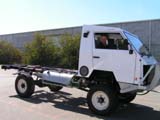
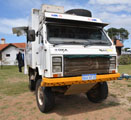
The left picture shows the new model, the OKA NT after
its "maiden" run, but still with a few parts missing.
The right picture is the OKA in 2017 with our back-section mounted.
The cabin is a welded steel frame covered by steel
plates and is roll over protected.
The NT still looks the same as the XT- and LT-models from the outside, but that's where most of the similarity ends.
The OKA NT is in many respects stronger and better
as its predecessor. Track width, wheelbase and overall
length are all slightly larger.
Since our truck is actually OKA's R&D model it still has an LT-cab. The NT cab didn't exist at that time.
OKA uses a lot of "standard" automotive
components to build their trucks which should make
it (hopefully) relatively easy to get most of the spare-parts
in the future, including outside of Australia.
These trucks are mainly used for military and mining
purposes as well as by the Australian tour-operators
for their trips into the rough outback. This truck
is perfectly suited to be used as a camper due to its
size, payload and ruggedness.
Our OKA NT cab-chassis is driven by a Cummins Euro 3, 4-cylinder,
4-litre turbo charged and inter-cooled diesel engine.
It delivers 170 HP and has an enormous torque of 600
Nm. Highway-speed is up to 120 kmh.
Due to price reasons we chose the 5-speed, cable
shifted manual transmission gearbox (New Venture 4500 HD).
4WD is engaged by a BAE/Vickers semi-permanent (also
cable shifted) transfer case.
The vehicle has cloth seat covers and tinted windows
and is registered to carry one driver and one passenger.
The trucks standard GVM is 6500 kg.
The whole suspension isn't sturdy enough for our wait and has too much play all over. We change the whole suspension with all its parts (spring package, shackles, shackle pins, bushes). All is done by the renowned Swiss company "Bieri Federn- u. Bremsservice AG" in Kriens, Luzern, Switzerland. The result is impressive. The OKA drives "like on rails". Below some details of the renovation.
   
Front suspension: The new spring packages are thicker (all 10 mm leaves) and nicely staggered. To avoid the drag link touching the spring package a spacer is required under the steering arm. On the right-hand side, a metal plate eliminates the notorious play.
  
Rear suspension: The new spring package and the new sturdy shackles. Front and rear are identical.
 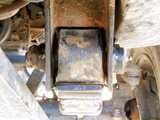 
The new 24 mm Spring pins and the new mounting hardware on chassis and shackles. They are of German quality. No play anywhere.


The two original round steel fuel tanks are replaced by new aluminium tanks of 160 and 190 l fuel capacity.
This gives us a fuel capacity of 350 l and a range of aprox. 1600 km.
In front of the right tank the AGM start battery is covered by
aluminium checker plate. OKA's main battery is normally
mounted on the opposite side and is not covered.
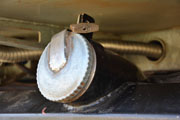
The original, lockable fuel caps constantly brake. We replace them with new types ("Blau" LKW Tankverschluss T 101; 01080-SV-908). OKA needs sealed caps because its tanks have airing lines. If the cap is also ventilated the diesel leaks if the OKA is in a sloping position. The tanks are now seriously sealed and locked - Fort Knox style

The tank capacity is increased, mainly for South America. 4 jerry cans are stored in a box on the roof rack. They are normally empty.
This adds up to a total of 450 litres of fuel which gives a range of aprox. 2100 km on the average fuel consumption of 21 l / 100 km.
  
In front of the left fuel tank are the heat exchanger and the 2 circulation pumps required for the floor heating. A compressed-air outlet can also be found here.
The step unfolds from the intermediate frame. It doesn't touch the ground.

The Eberspaecher diesel heating is mounted in the driver cab. This keeps the driver cab warm during the night and reduces the outside noise a bit. The downside is that the cab gets very hot in summer when generating hot water in the boiler using the trucks coolant system.
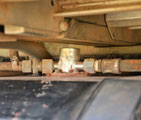
In South-America some tracks climb to an altitude over 5000 m above sea level.
During the night temperatures can fall below -20°C.
This is a problem for the diesel fuel because it may gel.
If this happens the motor cannot be started since the diesel clogs the fuel filter.
To overcome that problem we install an "Arctic Fox" diesel tank heater in the left tank. The warm water of the floor heating will now also heat the diesel in the tank. In addition, a high-altitude kit is installed on the diesel heating. It runs now up to 4500 m.

Each fuel tank has its own sediment bowl and filter
to trap water and dirt.
On the right side behind the diesel-filter, in the checker-plate case, is OKA's AGM starter-battery.
Above the diesel filter is the easy
accessible air filter.
Part of the dust from the
air filter exits just below the filter due to the overpressure
within the filter case.
Also due to the overpressure and the shape of the nozzle (Vacuator),
no water enters the filter even if submerged.
The snorkel is built into the cab bodywork.
Also on this side is a compressed air outlet mainly used to inflate tires.

Two strong recovery hooks at front are standard and
are bolted to the chassis.

The main lights are covered by strong stainless-steel
mesh as protection from flying rocks.
Between main lights and Hi-beams are LED flood lights.

Cables have been added between the cab and the roof-rack
to protect the cab from branches while driving through
bushland and forests.
Branches up to 5 cm simply bend
away or break.
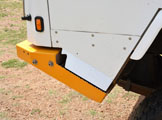

For improved security reasons on our world tour
the standard entry steps on the bumper are now covered
to prevent somebody from climbing on to the rolling truck.
This happened to Ruedi in his VW-camper in Italy in
1973.
Grade 8 Padlocks ("Abbus" 90/50 Titalium) have been added to further secure the doors and the side windows are now laminated and shatter proof.




The standard door lock can be forced open using a screwdriver.
This is easy because the door handles are made from plastic and offer no resistance.
The new door locks are reinforced with an aluminium plate to add more security.


The leaf springs have four layers under the eyelet
making them much less likely to break.
There are 4 double acting, gas charged shock absorbers
installed on the front axle (2 are optional).
Many of the vulnerable parts are protected by an aluminium bash
plate.
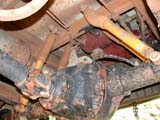
The back axle also has 4 shockies (2 optional) and
has an optional air operated diff lock installed.
Front and rear axles have no stabilisers (anti sway
bars) installed. The axles have an incredible articulation.
2011: After the many problems we had mainly with the diffs (2 axles and 8 diffs replaced on warranty) we decided to remove front and rear diff-locks for good.
Diff-Locks put a lot of strain on the drive train and our axles are of the worst possible build quality.
These two parameters simply don't match. In addition, our vehicle is very heavy and this adds even more strain to the whole system.

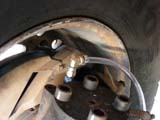
The hubs are prepared for "Central Tyre
Inflation".
Since there is a seal between hub (greased) and differential
(oiled) the hubs have breathers installed to
avoid water from entering the hubs while wading through
cold water.

Visible in the middle of the picture is the cable
shifted 2 stage transfer case and the flange bolted
drive shafts.
 
The transfer case is replaced in South America on warranty but fails again due to broken bearings in the shifter. Fortunately, this is relatively easy to fix out-bush.
2018: We replace the bearings in the shifter by metal-bushes to avoid further breakages.
The new transfer case is also very hard to shift. Working at another broken transfer case at OKA we find out that the play of two internal bearings on the input shaft were not adjusted during production. Adjusting the bearings cures the hard shifting. This seems to be a common problem of this particular transfer case.
Right behind the transfer case (visible as a round
thick disc) is the air actuated park break.
Since it
is connected to the transfer case it works on all 4
wheels if in 4WD. But it doesn't work at all in 2WD if one rear wheel is jacked-up.

Huge ventilated disc brakes are used on both axles.
They are power boosted by air over hydraulics.
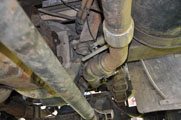
Due to our weight the brake power of the motor is insufficient. We decide to be the first client to install an exhaust brake, a "PacBrake". The result is fantastic. The exhaust brake is controlled by the electronic motor management system (ECM).
Never the less it can be manually switched on or off at any time using the brake pedal or accelerator.
At the same time, we exchanged the exhaust system with a stainless-steel version.
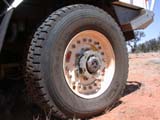
The 305/70 R 19.5 Michelin XDE 2+ tubeless tires are
mounted on "Titan"
19.5" x 8 1/4" bolt-together rims.
The front wheels are equipped with AVM free-wheeling
hubs to reduce fuel consumption while driving in 2WD.
The free-wheeling hubs are protected by hub steps.

The spare wheel is installed at the rear
end of the truck, adversely affecting the departure
angle.
8 GRP sand boards from "sandbleche.de" (150 x 40 cm) are mounted to the back-section. With 8 boards one is able to build a road. Very useful!
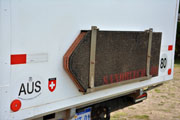
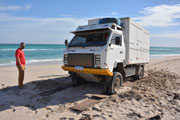 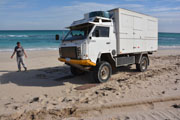
Instead of the hydraulic winch we use a manually operated "Habegger" HIT 32 winch. It has a lifting capacity of 3.2.t. For sure it is slower than a hydraulic winch and requires a lot of "elbow-grease", but time shouldn't be an issue. On the other hand, a hand- winch can be attached on any side of the truck (i.e. winching backwards or stabilizing the truck sideways).
If there is no anchor point available we will burry our spare wheel in soft terrain. For hard terrain we carry a set of large "steel pegs". Ground anchors have proven not to work at all.
Finding a decent anchor point is almost always a problem, but we carry about 100 m of Dynarope. That should do - hopefully.
The order in a recovery situation is almost always the same: Deflate the tyres, deflate the tyres, deflate the tyres. If this doesn't work jack-up the truck, place the truck on sandboards and build a road. Only if this also fails, use the winch.

OKA's standard dashboard takes up 2/3 of the cabin's
width. It contains all the standard instruments and
switches and has additional pre-defined slots for a
UHF CB-radio, some more instruments and switches.
The added UHF CB radio (not supplied by OKA) is at
the upper left corner to be operated mainly by the co-driver.
The radio/MP3 player (OKA supplies a different type)
has also an interface for an iPod
to be used as music source when no radio stations are available
in the outback. Never the less nobody will listen to music while driving the OKA. The noise of the truck is simply too loud.
The middle console holds (from left to right):
- UHF radio microphone
- Hot-standby GPS (mainly used for biking and hiking)
- Lever for the air-operated handbrake.

The console at the left side of the truck has been
custom built for navigation and holds the main GPS and
the tablet-PC mounted in its docking station. Both screens can be easily read even in sunlight.
In addition, email can be sent and received via the
IRIDIUM sat-phone using the "onsatmail" software.
This can be done even while driving on the road at
any time and on about any place in the world.
2016: The docking station has to be modified several times. On corrugated roads the tablet-PC has fallen out of the mounting and USB devises loose connection. USB connections in general are not off-road capable.
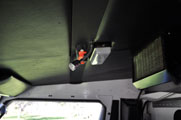
The co-pilot has its own spotlight. In front of the interior light is the emergency hammer to brake the side windows and beside is the fire/smoke detector which was installed because of the diesel-heater.
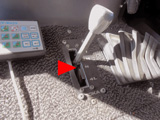
The motor bay has been insulated using a heavy carpet. This drastically reduces the mid- and hi-frequency noise in the cab (seen in Oz in David Hallendal's OKA).

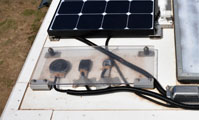
Behind the co-driver's seat a small shelf has been
fitted.
On top are 2 red boxes containing survival and medical
supplies.
Should the truck catch fire they can be removed
very quickly together with the sat-phone.
The sat-phone is located above the co-driver's seat
and the battery is constantly being charged.
The external antennas for the sat-phone and for both GPSs are
located on the roof of the back-section to guarantee
optimal reception. A polycarbonate cover protects the antennas. Even so the antennas are theoretically waterproof they must be mounted above the high-watermark on the roof!
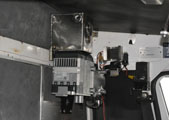
Above the red boxes, the Eberspaecher diesel heater is mounted.
Two additional handheld UHF CB-transceiver is located
inside the glove-box in their chargers.
The transceivers can be removed and used to keep contact
between the co-driver and the driver while the co-driver
is outside the vehicle or is examining the track ahead.
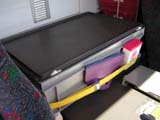 
Between the two seats Swiss made Rako-Boxes contain
all the paper maps, travel-guides and other items constantly
used.

A 6 kg foam-type fire extinguisher, an electronic
rust protection unit, other often used tools and some recovery gear are all located behind the
driver's seat.
Also 2 circuit breakers are installed in this area. One is used to disconnect the starter battery and the other to start the motor using the house battery.
Two breathing masks are mounted above the fire extinguisher on the back wall. They protect from smoke inhalation for 10 minutes. Condition is of course that the air still contains enough oxygen. 10 minutes should be enough to flee from fires out bush, in cities or to get to the next emergency exit in tunnels.
 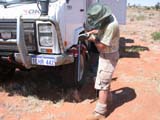
For more serious repairs a strong vice is part of the
extensive set of tools. It can be attached to both sides
of the bull bar. Since the inverter delivers up to 3000W permanent power,
standard drills, angle grinders and the like may be
used together with air driven tools such as a metal saw etc. The only thing we cannot do so far is serious welding, but this will change soon.
Over all the OKA is a real expedition type truck. |

![]() Created by Level X Webdesign
Created by Level X Webdesign